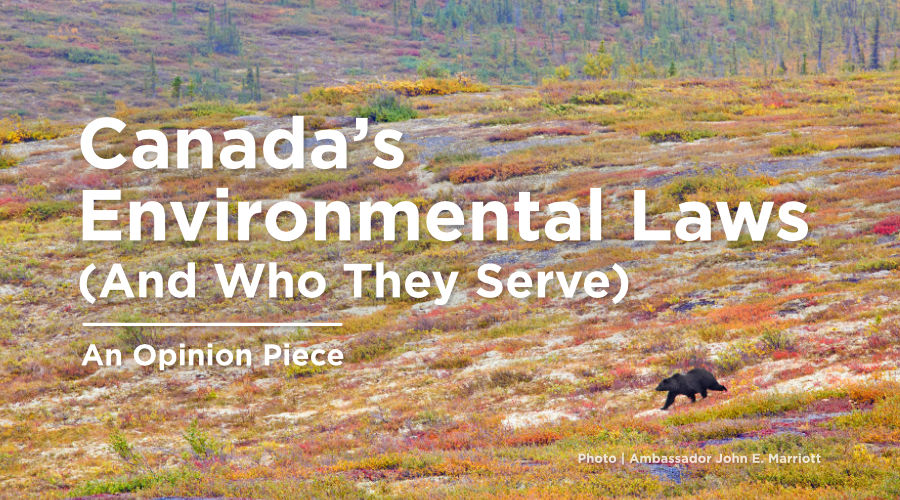
Canada often presents itself as a global leader in environmental protection. Tourism campaigns ship out images of vast forests, pristine rivers, and wide-open spaces. But the truth is more complicated. When you look closely at our laws, many are not written to protect ecosystems, but instead to accommodate industry.
So, who shapes our environmental rules? In theory, federal and provincial governments. In practice, lobbyists. Oil and gas, mining, and forestry lobbyists have direct access to decision-makers, while communities most impacted by environmental harm often struggle to be heard.
Take, for instance, the Canadian Environmental Assessment Act. It was created to ensure major projects such as pipelines, mines, and mega dams received a thorough review. In 2012, under Bill C-38, it was stripped down. Thousands of projects that once required scrutiny were suddenly approved with little oversight. Public participation was reduced, timelines were shortened, and the law’s effectiveness was undermined.
The Fisheries Act tells a similar story. It once protected all fish habitat in Canada. Then its language was narrowed to cover only fish of “commercial, recreational, or Aboriginal” value, leaving vast stretches of habitat vulnerable. Translation: habitat only matters if someone is making money from it.
The Impact Assessment Act, or Bill C-69, was intended to strengthen review processes. Industry labelled it the “no more pipelines bill.” In reality, while it introduced new requirements, it still left room for governments to override science when it was politically or economically convenient.
This pattern is familiar: when public demand for stronger protections rises, industry pressure pushes back, and governments yield. Laws weaken. Loopholes widen. And the cost is carried by wildlife, ecosystems, and future generations. Bill C-5 is the newest introduction to this pattern.
Enforcement is also lacking. A 2019 audit by Canada’s Commissioner of the Environment found that, despite thousands of violations of federal environmental law, very few resulted in prosecution or meaningful penalties. Companies just bake the fines into their budgets as the cost of doing business.
At the provincial level, the picture is no better. Alberta continues to erode habitat protections while accelerating approvals for oil and gas projects. In British Columbia, the Site C dam was greenlit despite significant environmental concerns, and logging continues in critical caribou and grizzly habitat.
The bottom line is this: Canada’s environmental laws are presented as safeguards, but too often they act as permission slips. A way to say “yes” to industry while pretending to say “no.”
Even when laws are weak, meaningful change requires advocacy. But here too, Canada’s system makes it difficult, and the road has long been shaky. For many years, registered charities in Canada were constrained by a so-called “10 percent rule,” which limited the amount of their resources (time or money) that could be put into political or advocacy activities under CRA interpretations. During the Harper government years, environmental charities and public interest groups were audited, scrutinized, and accused of exceeding these limits. Such audits targeted groups like the David Suzuki Foundation, West Coast Environmental Law, Environmental Defence, Tides Canada, and others. Many in the sector viewed the audits as punitive or politically motivated, and they fostered fear and caution.
Although the rules have since changed to allow greater engagement, the tension between the formal law and lived organizational behaviour remains. Across the nonprofit sector, there is what’s widely called “advocacy chill.” Organizations fear that speaking too loudly could still cost them their charitable status. Some foundations and corporations refuse to fund groups that engage in advocacy, fearing it could jeopardize their own government relationships. The result is a sector that, despite being closest to the realities on the ground, often finds itself constrained from challenging the very systems that are failing us.
This tension is striking: while the law now formally welcomes robust advocacy (within nonpartisan boundaries), structural fears, funding practices, and legacy attitudes still shape what many organizations feel they can do safely, leaving industry voices with disproportionate room to influence.\
It doesn’t have to remain this way. Laws can be rewritten, loopholes can be closed, and enforcement can be funded. And we, the public, can and must demand better.
Every time a community stands up, like those fighting pipelines across Indigenous territories, or protecting wetlands from development, or defending wildlife from trophy hunting and inhumane trapping, it sends a message: these laws aren’t working for us, and they need to change.
Pressure works. Communities have stopped pipelines, halted mines, and won protections for endangered species. The key is coordinated, persistent advocacy. Writing to Members of Parliament, showing up at town halls, supporting environmental organizations, and voting for candidates with strong ecological commitments all send a clear message: Canadians expect accountability and action.
Canada’s ecosystems are not infinite. Neither is our time. If environmental law continues to serve industry over people and planet, we all lose. The opportunity now is to decide whose interests these laws should serve, and to ensure they protect the living systems on which all of us depend.
As our resident Communications and Outreach Director, Sam brings a diverse range of experience and skills. From nature-based therapy and education, to brand strategy and research, her passion for science, creativity and storytelling has allowed Sam to work internationally on both grassroots projects and global campaigns. As a lover of wildlife and wild spaces, Sam has dedicated the past five years to working with conservation non-profits and education organizations across rural BC to inspire advocacy for the Canadian wild.